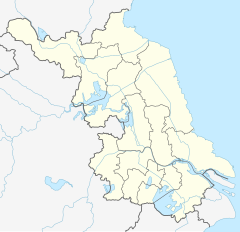| Huiji Temple | |
|---|---|
惠济寺 | |
| Religion | |
| Affiliation | Buddhism |
| Deity | Chan Buddhism |
| Leadership | Langming (朗明) |
| Location | |
| Location | Pukou District, Nanjing, Jiangsu |
| Country | China |
| Geographic coordinates | 32°06′08″N 118°31′16″E / 32.102182°N 118.521044°E |
| Architecture | |
| Style | Chinese architecture |
| Date established | Southern and Northern dynasties (420–589) |
| Completed | 19th century (reconstruction) |
| Website | |
| www | |
Huiji Temple (simplified Chinese: 惠济寺; traditional Chinese: 惠濟寺; pinyin: Huìjì Sì) is a Buddhist temple located in Pukou District of Nanjing, Jiangsu, China.[1]
History
Southern and Northern dynasties
Originally built in the Southern and Northern dynasties (420–589), the temple was called "Tangquan Chanyuan" (汤泉禅院).[1]
Song dynasty
In the early Song dynasty (960–1276), the temple was renamed "Huiji Yuan" (惠济院). During the reign of Emperor Shenzong (1048–1085), Zhaoqing (昭庆) settled at the temple. At the same time, Sun Jue (孙觉), Qin Guan and monk Canliao (参寥) visited the temple and Qin Guan wrote a famous article named A Record of Touring Tangquan (游汤泉记).[1]
Ming dynasty
After the establishment of the Ming dynasty (1368–1644), Hongwu Emperor toured Tangquan Town where the temple located. Due to the social taboo of "Tang" (汤), its name was changed to "Xiangquan Temple" (香泉寺).[1]
Qing dynasty
During the Xianfeng era (1851–1861) of the Qing dynasty (1644–1911), the temple was badly damaged in the war between the Qing army and Taiping Rebellion. Then the temple was restored in the Guangxu period (1871–1908).[1]
People's Republic of China
A large-scale reconstruction began in 2014.[1][2]
Ginkgo tree
There are three millennial ginkgo trees in the temple.[1]
References
- ^ a b c d e f g 南京惠济寺将复建,尽显“大唐范儿”(组图). 163.com (in Chinese). 2014-11-19.
- ^ Chang Fen (2014-11-13). 千年古刹南京惠济寺复建 书画家义捐作品筹善款. iFeng (in Chinese).
External links
- Official website (in Chinese)


